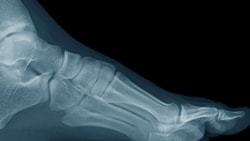Femoral Stress Fractures: Assessment and Treatment
February 21, 2017
3 min. read

Stress fractures are common among members of the military, runners, and endurance athletes. With an incidence of 31% in military personnel and 21% in track and field athletes, this area needs to be thoroughly understood by clinicians working in a direct access environment.
While femoral stress fractures only account for 5-7% of all stress fractures, there is currently no validated clinical decision rule to identify those at risk. So, we need to consider all factors when assessing and treating femoral stress fractures.3,8,13,14,15,16
What Causes a Femoral Stress Fractures?
Stress-related bone and soft-tissue injuries occur in response to an excessive progression of repetitive loading activities. These injuries develop when the extent of the micro-damage exceeds the ability of the remodeling process to keep up with the demands placed upon it. With regards to femoral stress fractures, during running, the largest bending moments about the anterior to posterior axes of the proximal femur occurs during the impact phase of loading response. As this occurs, the largest stress is then placed on the medial aspect of the femur.7
Who is at Risk?6,8
Stress fracture injury rates are highest in girls cross country, girls gymnastics, and boys cross country. In endurance athletes, female sex (odds ratio = 2.31) and a history of stress fracture (OR = 4.99) are significant risk factors. The presence of concomitant ipsilateral femoroacetabular impingementshows a higher incidence in both the general and military populations.9,10Sudden increases in training volume, especially in relatively inactive individuals, also elevates risk.
What is the Clinical Presentation?6,11
Vague pain in the thigh that radiates into the hip and/or groin region can indicate a femoral stress fracture.Patients may also present with the following:
Anterior thigh (45.9%), hip (27.0%), and/or groin (8.1%) pain
Groin pain with single leg hop (70%)
Hip A/PROM not typically limited, but can be painful (femoral shaft stress fractures)
Gross limitation in A/PROM can be present in femoral neck stress fractures
What Special Testing Can We Use?1,2
The patellar-pubic percussion test can help identify femoral stress fractures. The sensitivity, specificity, and +LR shown below suggest that a positive result on this test may change the probability of a positive stress fracture diagnosis.
| Patellarpubic Percussion Test | ||||
|---|---|---|---|---|
| Reliability | Sensitivity | Specificity | +LR | -LR |
| .89 | .89 - .96 | .82 - .95 | 5.1 - 20.4 | .06 - .75 |
The fulcrum test may also beuseful when screening for stress fractures:
| Fulcrum Test | ||||
|---|---|---|---|---|
| Reliability | Sensitivity | Specificity | +LR | -LR |
| N/A | 1.00 | 1.00 | 0.00 | |
Is Conservative Management Effective?
Several case reports and case series show successful diagnosis, treatment, and return to sport following conservative management. Unfortunately, at this time, no high-level studies support physical therapy as an intervention in this population. In those cases of successful management, programs included progressive posterolateral hip strengthening, neuromuscular re-education, and a graded return to running/physical activity.4,5,11
Without the clinical decision rules for identification of fracture that are available for the foot/ankle (Ottawa Ankle Rules), knee (Ottawa Knee Rules, Pittsburgh Knee Rules), and cervical spine (Canadian Cervical Spine Rules), evaluation of a potential femoral fracture needs to be managed with the best available evidence. By taking into consideration patient demographics, subjective report of training volume/progression, and using tests/measures supported in the literature, we can more accurately identify those athletes in need of further radiological evaluation.
Below, watch Barb Hoogenboom discuss risk factors for stress fractures in female athletes in a short video from her course, The Female Athlete Triad.






